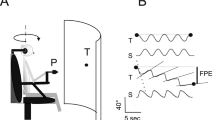Summary
Subjects were investigated in a bed rotatable about two axes. With the head erect and the body in a standing, semi-prone or prone position (= pitch) the subject was tilted to the right to one of eight positions between 0° and 150° of roll. During eight minutes the subject aligned a luminous line with the subjective vertical (SV). Differences in the SV between the pitch positions of body were significant for roll tilts above 90°. Individuals differed in the way the SV changed between 90° and 150°, in the scatter in the settings from repeated experiments, and in the degree of influence of pitch positions (= somatoreceptor stimulation). The SV exhibited a distinct time-dependence which was different at tilts below 70° and above. It is concluded that from the two determinants of the SV one (somatoreceptors) loses effectiveness in time because of adaptive processes, while the other (labyrinth) loses effectiveness with increasing deviation of head position from the normal upright; their relative weighting differs from individual to individual.
Similar content being viewed by others
References
Bauermeister, M., Wapner, S.: Beiträge zur sensori-tonischen Feldtheorie der Wahrnehmung. I. Visuelle und taktilkinästhetische Wahrnehmung der vertikalen Raumrichtung bei seitlicher Körperneigung. Psychol. Forsch. 31, 246–260 (1967)
Bischof, N.: Stellungs-, Spannungs- und Lagewahrnehmung. In: Handbuch der Psychologie, Bd. 1, 409–497 Berlin, Göttingen, Heidelberg: Springer 1966
Bohring, E.G.: Sensation and perception in the history of experimental psychology. New York: Appleton-Century 1942
Brown, J.L.: Orientation to the vertical during water immersion. Aerospace Med. 32, 209–217 (1961)
Clark, B., Graybiel, A.: Perception of the postural vertical following prolonged bodily tilt in normal and subjects with labyrinthine defects. Acta oto-laryng. 58, 143–148 (1964)
Cohen, L.A.: Contributions of tactile, musculo-tendinous and joint mechanism to position sense in human shoulder. J. Neurophysiol. 21, 563–568 (1958)
Correia, M.J., Hixson, W.C., Niven, J.I.: Otolith shear and the visual perception of force direction: discrepancies and a proposed solution. Nami-951. Nasa Order R-93. Pensacola: Naval Aerospace Medical Institute 1965
Dichgans, J., Brandt, Th., Held, R.: The role of vision in gravitational orientation. Fortschr. d. Zool. 23, I, 255–264 (1975)
Fischer, M.H.: Messende Untersuchungen über die Gegenrollung der Augen und die Lokalisation der scheinbaren Vertikalen bei seitlicher Neigung des Gesamtkörpers bis zu 360°. II. Untersuchungen an Normalen. v. Graefes Arch. Ophthal. 123, 476–508 (1930 a)
Fischer, M.H.: Messende Untersuchungen über die Gegenrollung der Augen und die Lokalisation der scheinbaren Vertikalen bei seitlicher Neigung des Körpers, Kopfes und Stammes. III. Untersuchungen an einem Ertaubten mit Funktionsuntüchtigkeit beider Vestibularapparate und einem einseitig Labyrinthlosen. v. Graefes Arch. Ophthal. 123, 509–531 (1930 b)
Fitger, C.: Tactile-kinesthetic space estimation: The influence of gravity. Psyhol. Res. 39, 113–135 (1976)
Fleishman, E.A.: Perception of body position in the absence of visual cues. J. Exp. Psychol. 46, 261–270 (1953)
Gibson, J.J.: The senses considered as perceptual systems. New York: Houghton Mifflin Company Boston 1966
Gibson, J.J., Mowrer, O.H.: Determinants of the perceived vertical and horizontal. Psychol. Rev. 45, 300–323 (1938)
Graybiel, A., Clark, B.: Perception of the horizontal or vertical with head upright, on the side, and inverted under static conditions, and during exposure to centripetal force. Aerospace Med. 33, 147–155 (1962)
Guedry, F.E.: Psychophysics of vestibular sensation. In: Handbook of Sensory Physiol. VI/2 Berlin, Heidelberg, New York: Springer 1974
v. Holst, E.: Die Arbeitsweise des Statolithenorganes bei Fischen. Z. vgl. Physiol. 32, 60–120 (1950)
Howard, I.P., Templeton, W.B.: Human spatial orientation. New York: Wiley 1966
Miller, E.F., Graybiel, A.: Role of the otolith organs in the perception of horizontality. Am. J. Psychol. 79, 24–37 (1966)
Schöne, H.: Über den Einfluß der Schwerkraft auf die Augenrollung und auf die Wahrnehmung der Lage im Raum. Z. vgl. Physiol. 46, 57–87 (1962)
Schöne, H.: On the role of gravity in human spatial orientation. Aerospace Med. 35, 746–772 (1964)
Schöne, H.: The “weight” of gravity organ's signal in the control of perceptual and reflex type orientation at different body positions. Fortschr. d. Zool. 23, 1, 274–283 (1975)
Schöne, H., Parker, D.E.: Inversion of the effect of increased gravity on the subjective vertical. Naturwiss. 54, 288–289 (1967)
Schöne, H., Udo de Haes, H.: Perception of the gravity vertical as a function of head and trunk position. Z. vgl. Physiol. 60, 440–444 (1968)
Schöne, H., Udo de Haes, H.: Space orientation in humans with special reference to the interaction of vestibular, somaesthetic and visual inputs. Biokybernetik III, Materialien 2. Internat. Sympos. Biokybernetik, pp. 172–191. Jena: VEB Fischer 1971
Schöne, H., Wade, N.: The influence of force magnitude on the perception of body position. II. Effect of body posture. Br. J. Psychol. 62, 3, 347–352 (1971)
Sherrington, C.S.: The integrative action of the nervous system. Cambridge: University Press 1906
Udo de Haes, H.: Stability of the apparent vertical and ocular countertorsion as a function of lateral tilt. Perception and Psychophysics 8, 3, 137–142 (1970 a)
Udo de Haes, H.: The effectiveness of the statolith organs in human spatial orientation. Thesis, Leiden (1970 b)
Wade, N.J.: Visual orientation during and after lateral head, body and trunk tilt. Perception and Psychophysics 3, 215–219 (1968)
Wade, N.J.: The interaction of postural systems in visual orientation. Percept. Psychophys. 6, 309–310 (1969 d)
Wade, N.J.: Effect of prolonged tilt on visual orientation. Quart. J. Exp. Psychol., Vol. XXII, 3, 425–439 (1970)
Werner, H., Wapner, S., Chandler, K.: Experiments on sensoritonic field theory of perception. II. Effects of supported and unsupported tilt of the body on the visual perception of verticality. J. Exp. Psychol. 42, 346–350 (1951)
Author information
Authors and Affiliations
Rights and permissions
About this article
Cite this article
Lechner-Steinleitner, S. Interaction of labyrinthine and somatoreceptor inputs as determinants of the subjective vertical. Psychol. Res 40, 65–76 (1978). https://doi.org/10.1007/BF00308464
Received:
Issue Date:
DOI: https://doi.org/10.1007/BF00308464




